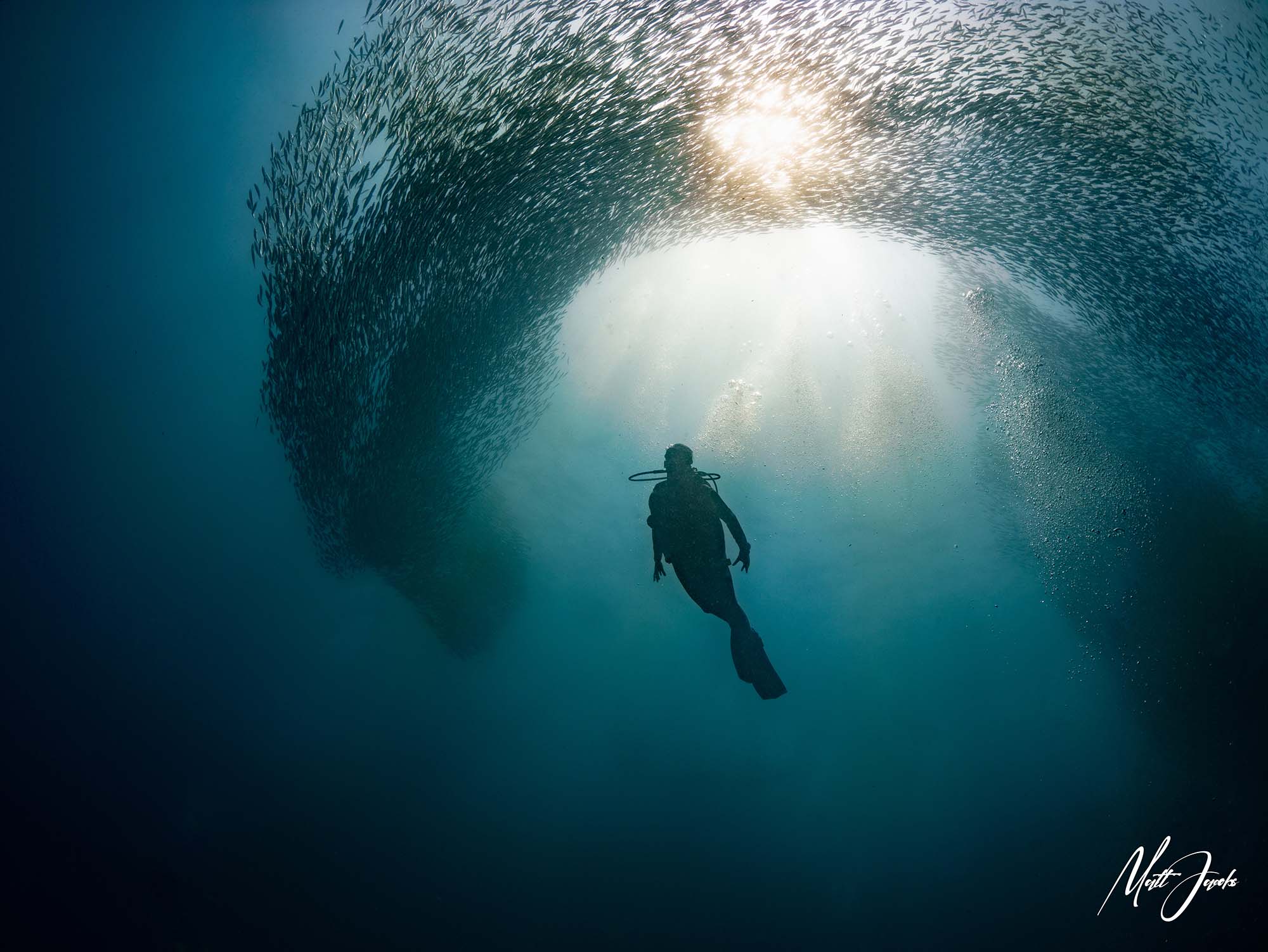By Bryant Turffs
All images © 2024 Bryant Turffs
I have a clear view of mount Fuji over the dive site as I struggle into my borrowed 7mm wetsuit. I am at a site called Jogoshima at the mouth of Tokyo Bay and the water temperature is a chilling 64°F (17.7ºC) for my Floridian bones. My partner, Jessica, and I have traveled to Japan to visit friends who are stationed near Tokyo. We arrived only yesterday and the excitement of our first dive, and an excessive amount of coffee, keeps me wide awake despite the jet lag. We plan to spend two weeks in country visiting Tokyo, Okinawa, and the island of Ishigaki.

Jessica and I at Jogoshima
The Jogoshima dive, typical for the area, is a rocky reef covered in kelp and other algae / sea weeds. Exotic (to me) fishes ply the crevices of the reef in search of food. Our primary quarry at this site nudibranchs also prove plentiful, diverse, large and colorful! After 75 minutes my rented 63 cubic foot tank is approaching the 500 psi mark and I am forced out of the water. Elated about the dive, I am sorry that we didn’t plan more diving in the area. The following two days, we have planned to visit Tokyo, and to do a hike nearby before moving on to Okinawa where the diving will start in earnest.
The first challenge I faced for this trip was deciding how to pack. It can be daunting to travel with full dive and camera kits. Our scuba gear, which could be more travel friendly, fills two large duffel bags. Fortunately, our Ikelite 200 DLM housings prove compact and easy to pack. I’m traveling with my Canon R7, a fisheye lens, and two DS232 strobes. Jessica will be shooting macro with our older Canon Rebel SL system. I like for the camera kit to be carry on so that I can ensure it is handled gently and that it makes to the final destination. It takes a bit of ingenuity, but I manage to fit both our complete rigs into one carry on bag. I won’t lie, the bag is heavy and this could be a concern if the airlines weigh carry ons, but I have been assured this won’t be the case in Japan.

Sea Krait at Kerama
Okinawa
Upon landing in Okinawa, we drive our rental car straight to a dive shop in the town of Chatan and kit up for a shore dive along the sea wall. At 26° N latitude, Okinawa has a similar climate to my home in Florida. The water temperature is a welcoming 75ºF (23.8ºC). I have no idea what to expect from this first dive and am pleasantly surprised by the diverse reef, rich in coral abundance, with dramatic spur and groove topography. We encounter sea snakes, abundant tropical pacific fishes, and enough nudibranchs to satisfy Jessica’s macro addiction. Although, I don’t wind up shooting video on this trip (I am a stills shooter at heart) I find the DS232’s powerful video lights to be a great tool when searching reef overhangs for macro subjects. They illuminate a huge area and it’s nice not to carry an additional light.

Manza Anemone Fish
Over the next three days in Okinawa we visit three different sites by boat. The first day is at a place called Manza. I really enjoy these beautiful reef dives where we see a variety of subject matter from anemone fish, to green sea turtles, and tiny Shawn the sheep nudibranchs. On these dives I primarily shoot close focus wide angle imagery. I use the optional dome diffusers on my DS232 strobes to create soft and even lighting for the close-up subjects.

Jackfish School
On the second and third days we visit Aguni island and the Kerama Islands. These sites feel more oceanic with dramatic volcanic geography, strong currents, and relatively sparse reefs. The hope is to encounter pelagic marine life, schools of trevally and sharks at Aguni and giant mantas at the Keramas. At Aguni, we get our school of bigeye trevally and my DS232 strobes, without the diffuser, are adept at throwing a huge amount of light across the large school of fish. At the Keramas we aren’t blessed with a giant manta, pelagic creatures are always hit or miss, but we enjoy the regular cast of turtles, sea snakes, anemone fishes, and eels. On our last morning in Okinawa, reflecting on all that we have seen here, I’m left wishing that we had more time to explore. There are additional dive sites both boat and shore accessible, and a protected natural area at the north end of the island that I would love to have visited! All reasons to return, I suppose.

Aguni Soft Coral

Reef Manta, Ishigaki

Diver’s Watching Mantas, Ishigaki
Ishigaki
Our final stop of the trip is the island of Ishigaki, at the southern end of Okinawa prefecture, a stone’s throw from Taiwan. Ishigaki is a popular tropical dive destination for the Japanese, but I had barely heard of it before planning our trip. Reliable sightings of reef manta rays are a main draw of Ishigaki, along with coral reefs and their usual inhabitants. Over our three days of diving, Prime Scuba provides excellent service and a comfortable vessel. We visit a manta cleaning station twice and sight multiple reef mantas on each dive. This sight is very popular, but fortunately, it is very well managed and respectful of the rays. A limited number of boats are allowed on sight at any time and divers are kept low and away from the immediate vicinity of the cleaning station. On other dives we find large and colorful nudibranchs, octopus, pipefish, leafy scorpionfish, batfish, and lovely coral. My canon R7, 8-15mm fisheye, and 200DLM housing proves reliable and adept at shooting this wide array of life. Its certainly not a macro set up, but I am able to capture large nudibranch’s when zoomed into 15mm and mantas when zoomed out to 10mm.

Ishigaki Coral

Ishigaki Nudibranch
On our last morning in Ishigaki, Jessica and I drive our rental car into the hills in the hopes of sighting some of the island’s rare bird species. It is pouring down rain as it has been for the last week or so. I suppose its a good sign about the trip that I had forgotten to mention the rain to this point! We dart in and out of the car during breaks and I am about to give up when Jessica points deep into the dense foliage. We get a split second glimpse of a ruddy kingfisher just before we have to return to the airport for the journey home. The long flights ahead and the wonderful experience behind makes me wish I could stay!

Ishigaki Turtle Silhouette
Additional Reading
My Floridian Ikelite System // Bryant Turffs' Underwater Photography Gear [VIDEO]
Get Creative: Unconventional Handle and Strobe Setups
Macro Minded: Creating Meaningful Underwater Macro Photo and Video
Bryant Turffs' Set-Up Tips // Ikelite Underwater Housing for Canon R7 [VIDEO]
Motion Blur Underwater Photography Settings and Technique
 Ambassador Bryant Turffs has worked on six of the seven continents as a biologist, boat captain, dive professional, commercial fisherman, photographer, and educator. Today he lives in Palm Beach County, Florida, and works with his partner, Jessica Pate, to understand the mysteries of the local manta ray population. He also uses his photography to tell other natural history and conservation stories. Read more...
Ambassador Bryant Turffs has worked on six of the seven continents as a biologist, boat captain, dive professional, commercial fisherman, photographer, and educator. Today he lives in Palm Beach County, Florida, and works with his partner, Jessica Pate, to understand the mysteries of the local manta ray population. He also uses his photography to tell other natural history and conservation stories. Read more...













![Diving the Cape Peninsula // South Africa Underwater [VIDEO]](http://www.ikelite.com/cdn/shop/articles/South_Africa_Stories_from_the_Field_copy.jpg?v=1723140916&width=2000)